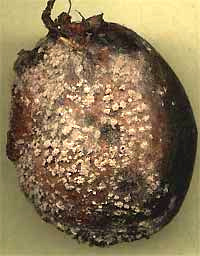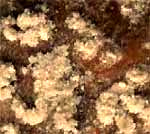(SOURCE: NCBI database)
KINGDOM: Fungi
DIVISION: Ascomycota
CLASS: Leotiomycetes
ORDER: Helotiales
FAMILY: Sclerotiniaceae
GENUS: Monilinia
SPECIES: fructicola

Certain locations just can't grow peaches or nectarines because of Brown Rot Disease caused by the fungus Monilinia fructicola. A much diseased nectarine is shown at the left, and a close-up of the fungus appears below.

The above fruit is gradually drying out and if it had not been picked eventually would have formed a dark, puckery "mummy" or stroma. Some mummies fall off before winter arrives, while others remain on the tree until spring.
When spring arrives, the fungus produces two types of blossom-infecting spores. On fruit mummies and cankers on the tree, growing hyphae asexually produce spores called conidia. The second way spores are produced is from apothecia on mummies lying on the ground. These spores are sexually produced.
The asexually produced conidia infect ripening fruit. The white patches on our mummies are conidia ready to be spread by the wind or rain, or carried away by visiting insects.
This is a hard disease to get rid of! Of course, one important way to reduce the chance of getting the disease the next season is to remove fruit mummies and other obviously infected parts of the tree. However, many would say that once the disease is established in your orchard, you might as well forget about growing peaches in the future, unless you're willing to do a lot of fungicide spraying.